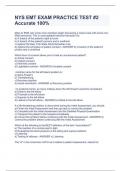Summary
SUMMARY Edexcel IAL Biology - Topic 2;Membranes, Protein, DNA and Gene Expression
- Module
- Unit 1 (BXI11)
- Institution
- PEARSON (PEARSON)
Unit 1 Topic 1; Molecules, Transport and health summary in the Pearson Edexcel International AS/A level Biology Student book 1. - Includes all specification points. - Paper (WBI11/01) - Aesthetic layout
[Show more]












